Saviez-vous que WordPress peut mettre à jour automatiquement votre site web ? Dans certains cas, cela peut inclure les extensions et les thèmes.
Les mises à jour automatiques de WordPress améliorent la sécurité, mais les inconvénients potentiels peuvent l'emporter sur les avantages pour certains propriétaires de sites web. Nous avons constaté par expérience que ces mises à jour en arrière-plan peuvent parfois entraîner des problèmes inattendus, elles peuvent même casser votre site dans de rares cas.
Pour conserver le contrôle total de votre environnement WordPress, vous pourriez vouloir désactiver complètement les mises à jour automatiques.
Dans cet article, nous vous montrerons comment désactiver les mises à jour automatiques dans WordPress, afin que vous puissiez effectuer les mises à jour manuellement vous-même.
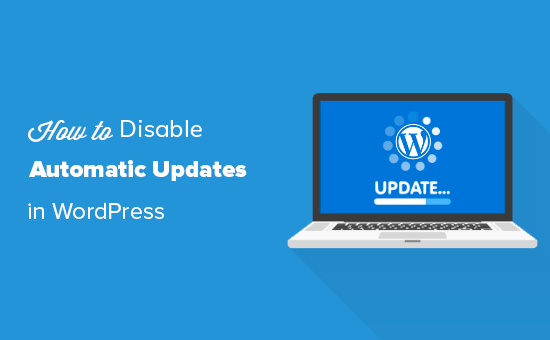
Pourquoi WordPress met à jour automatiquement
WordPress met automatiquement à jour le logiciel cœur de WordPress pour des raisons de sécurité.
Parfois, il peut également mettre à jour une extension ou un thème pour corriger une menace potentielle. Par exemple, une extension ou un thème WordPress pourrait être mis à jour pour supprimer une vulnérabilité critique. Si cette extension ou ce thème est utilisé par de nombreux sites web, l'équipe du cœur de WordPress peut publier une mise à jour automatique pour celui-ci.
En dehors de ces situations, WordPress vous laisse décider quand vous souhaitez installer les mises à jour.
Nous ne recommandons pas de désactiver les mises à jour automatiques de WordPress. Elles constituent une fonctionnalité de sécurité importante.
Cependant, dans certaines situations rares, les mises à jour peuvent casser votre site web ou affecter sa fonctionnalité. Cela pourrait vous faire perdre des clients et des affaires.
Si vous êtes confiant dans votre capacité à gérer vous-même les mises à jour manuelles, vous pouvez alors désactiver en toute sécurité les mises à jour automatiques dans WordPress.
Nous vous montrerons deux méthodes simples pour désactiver les mises à jour automatiques de WordPress, l'une utilisant du code et l'autre un plugin, afin que vous puissiez choisir l'approche qui vous convient le mieux. Utilisez simplement les liens rapides ci-dessous pour accéder directement à la méthode que vous préférez :
- Méthode 1. Désactiver les mises à jour automatiques de WordPress à l'aide de code (recommandé)
- Méthode 2. Configurer et désactiver les mises à jour automatiques de WordPress avec un plugin
- Avantages et inconvénients des mises à jour automatiques de WordPress
- Should I Disable Automatic WordPress Updates?
Méthode 1. Désactiver les mises à jour automatiques de WordPress à l'aide de code (recommandé)
Si vous souhaitez la manière la plus simple et la plus sûre de désactiver les mises à jour automatiques de WordPress sans toucher à votre thème ou à vos fichiers principaux, le plugin gratuit WPCode est votre meilleure option.
Généralement, pour désactiver les mises à jour automatiques à l'aide de code, vous devrez modifier le fichier functions.php de votre thème et le fichier wp-config.php, ce qui peut être risqué si vous n'êtes pas prudent.
Cependant, WPCode vous permet d'ajouter des snippets de code directement depuis votre tableau de bord WordPress, il n'est donc pas nécessaire de modifier manuellement des fichiers. Cela réduit le risque de casser accidentellement votre site.

De plus, il est livré avec une bibliothèque de code intégrée où vous pouvez trouver des snippets de code populaires tels que la désactivation des mises à jour automatiques de WordPress, la désactivation de l'API REST, l'autorisation des téléchargements de fichiers SVG, la désactivation des commentaires, et plus encore. Cela élimine le besoin d'installer une multitude de plugins à usage unique.
Note : Le plugin gratuit WPCode a tout ce dont vous avez besoin pour ajouter du code personnalisé dans WordPress. Si vous souhaitez des fonctionnalités avancées telles qu'une bibliothèque de snippets dans le cloud privé, des pixels de conversion, des snippets planifiés, des révisions de code, et plus encore, vous pouvez passer à WPCode Pro.
Pour commencer, vous devez installer et activer le plugin gratuit WPCode. Si vous avez besoin d'aide, consultez notre guide sur comment installer un plugin WordPress.
Une fois le plugin activé, accédez à Snippets de code » Bibliothèque depuis votre tableau de bord d'administration WordPress.
Ensuite, recherchez le snippet « Désactiver les mises à jour automatiques » et cliquez sur le bouton « Utiliser le snippet ».
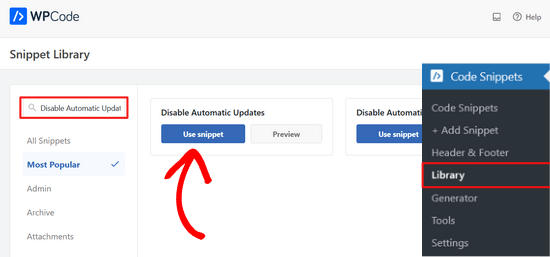
WPCode ajoutera alors automatiquement le extrait de code et sélectionnera la méthode d'insertion appropriée.
Le extrait de code possède trois filtres pour désactiver les mises à jour du cœur de WordPress, les mises à jour des extensions et les mises à jour des thèmes.
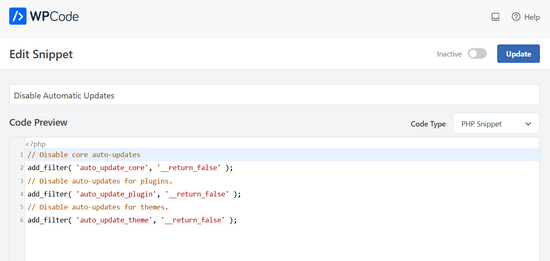
Si vous ne souhaitez pas utiliser l'un de ces filtres, modifiez simplement le code pour ajouter un // au début de la ligne du filtre.
Par exemple, ajouter un // à la ligne du filtre de mise à jour automatique du cœur empêchera son exécution. Ainsi, vous obtiendrez toujours les mises à jour automatiques pour le cœur, mais pas pour les extensions et les thèmes.
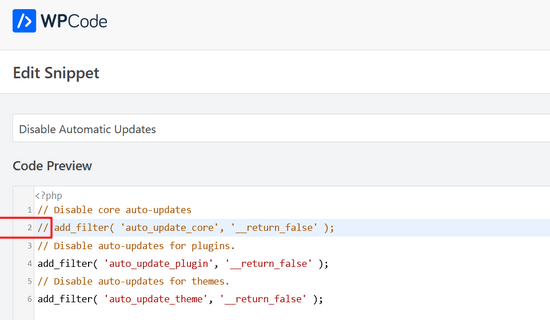
Après cela, tout ce que vous avez à faire est de basculer l'interrupteur de « Inactif » à « Actif ».
Ensuite, cliquez sur le bouton « Mettre à jour ».

C'est tout. Vous avez maintenant désactivé les mises à jour automatiques dans WordPress.
Alternative : Si vous êtes à l'aise avec les fichiers WordPress, vous pouvez désactiver les mises à jour automatiques en ajoutant cette ligne de code dans votre fichier wp-config.php :
define( 'WP_AUTO_UPDATE_CORE', false );
Cela désactivera toutes les mises à jour automatiques de WordPress.
Important : Assurez-vous de lire notre article sur comment modifier en toute sécurité le fichier wp-config.php dans WordPress pour des instructions étape par étape.
Si vous souhaitez recevoir les mises à jour mineures du cœur, mais désactiver les mises à jour des thèmes et des extensions, vous pouvez le faire en ajoutant les filtres suivants dans le fichier functions.php de votre thème :
Désactiver les mises à jour automatiques des extensions WordPress :
add_filter( 'auto_update_plugin', '__return_false' );
Désactiver les mises à jour automatiques des thèmes WordPress :
add_filter( 'auto_update_theme', '__return_false' );
Méthode 2. Configurer et désactiver les mises à jour automatiques de WordPress avec un plugin
Une autre façon de désactiver les mises à jour automatiques de WordPress est d'installer et d'activer le plugin Easy Updates Manager. Si vous n'êtes pas sûr de la procédure, consultez notre guide étape par étape sur comment installer un plugin WordPress.
Une fois le plugin activé, allez dans Tableau de bord » Options de mise à jour pour configurer vos paramètres.
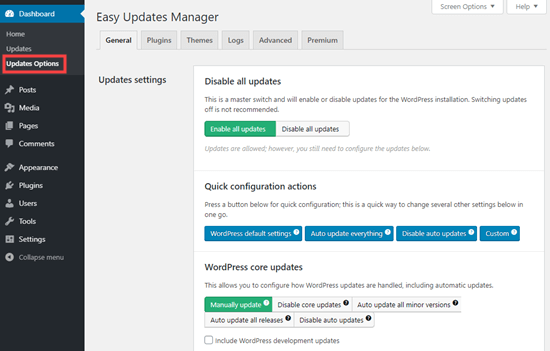
Vous pouvez choisir de « Désactiver toutes les mises à jour », mais nous ne recommandons pas cette option. Principalement parce qu'elle empêchera l'apparition de toutes les notifications de mise à jour.
Au lieu de cela, vous devriez choisir les paramètres que vous souhaitez. Vous pourriez désactiver les mises à jour automatiques des plugins et des thèmes, mais laisser les mises à jour automatiques standard du cœur de WordPress activées.
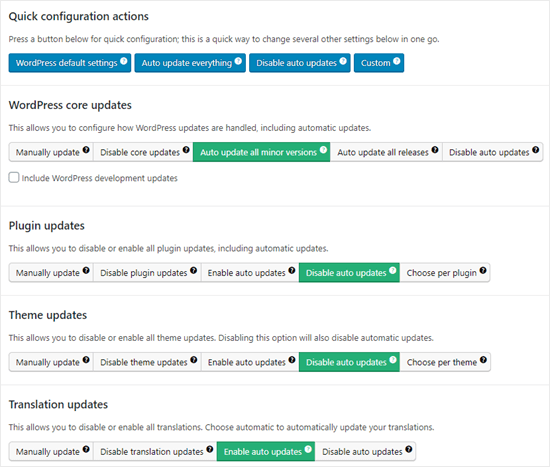
Remarque : Si vous choisissez « Désactiver les mises à jour des plugins » et « Désactiver les mises à jour des thèmes » au lieu de « Désactiver les mises à jour automatiques », vous ne verrez même pas les notifications de mise à jour dans vos listes de plugins et de thèmes.
Easy Updates Manager conserve un journal de ce qui a été mis à jour, donc si quelque chose casse votre site, vous pouvez revenir à une version précédente fonctionnelle. Pour cela, allez dans Tableau de bord » Options de mise à jour, puis cliquez sur l'onglet « Journaux ».
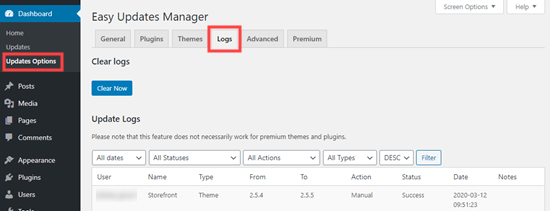
Il existe également une version premium d'Easy Updates Manager, qui offre de nombreuses options supplémentaires.
Par exemple, il s'intègre avec UpdraftPlus, l'un des plugins de sauvegarde WordPress les plus populaires, afin que vous puissiez exécuter automatiquement une sauvegarde de votre site avant que les mises à jour ne soient appliquées.
Avantages et inconvénients des mises à jour automatiques de WordPress
Vous savez maintenant comment désactiver les mises à jour automatiques, mais devriez-vous les désactiver ? Il n'y a pas de bonne réponse, et cela dépend de vous et de votre site web.
Sur nos sites, nous avons désactivé les mises à jour automatiques des plugins et des thèmes, tout en gardant activées les mises à jour mineures du cœur.
Examinons les avantages et les inconvénients des mises à jour automatiques. Ainsi, vous pourrez décider de désactiver ou non les mises à jour automatiques sur votre site.
Avantages des mises à jour automatiques dans WordPress
Les mises à jour automatiques sont excellentes pour la sécurité WordPress. De nombreux utilisateurs oublient de mettre à jour leurs plugins ou leur installation WordPress de base.
Avec les mises à jour automatiques de WordPress activées, vous n'avez pas à vous soucier de mettre à jour votre site chaque fois qu'une mise à jour mineure de WordPress est publiée. Celles-ci sont diffusées à des fins de maintenance et de sécurité.
Dans le passé, les mises à jour automatiques étaient quelque chose que l'on obtenait uniquement en payant pour un hébergement WordPress géré. Maintenant, elles sont disponibles pour tout le monde (du moins pour les versions mineures).
Vous savez aussi que s'il y a un problème de sécurité crucial avec WordPress ou un plugin populaire, alors WordPress se mettra à jour automatiquement. Même si vous êtes occupé ou loin de chez vous, votre site restera sécurisé.
Si vous avez beaucoup de sites, alors les mises à jour automatiques peuvent vous faire gagner beaucoup de temps. Et même si vous n'avez qu'un seul site, vous pourriez préférer la tranquillité d'esprit de savoir que WordPress s'occupe de tout.
Inconvénients des mises à jour automatiques dans WordPress
L'équipe principale de WordPress responsable de la publication des mises à jour s'assure qu'elles se déroulent sans accroc.
Cependant, il y a une légère possibilité que les mises à jour automatiques puissent casser votre site. D'après notre expérience, les versions mineures n'ont pas encore cassé nos sites.
C'est parce que nous suivons les meilleures pratiques et que nous ne modifions aucun fichier du cœur. Si vous modifiez les fichiers du cœur de WordPress, alors ces mises à jour automatiques peuvent les remplacer.
Si WordPress jugeait nécessaire de pousser une mise à jour de sécurité pour un thème que vous utilisez, il y a une chance que cela casse votre site web. Cela s'applique particulièrement si vous avez modifié les fichiers de votre thème.
Les mises à jour automatiques de plugins peuvent potentiellement casser votre site également. Il y a trop de variables, comme différents environnements de serveur et combinaisons de plugins.
Il est maintenant important de savoir que ces mises à jour ne casseront pas la grande majorité des sites web. Même ainsi, vous pourriez estimer que vous ne voulez pas prendre le risque.
Un autre inconvénient est que vous ne recevrez pas toujours automatiquement une notification lorsque votre site est mis à jour.
Dois-je désactiver les mises à jour automatiques de WordPress ?
Essentiellement, c'est à vous de prendre cette décision.
Pour la plupart des débutants et la grande majorité des sites WordPress, les mises à jour automatiques sont inoffensives et vous ne devriez pas les désactiver.
Cependant, si vous gérez une boutique en ligne ou si vous ne voulez pas perdre de clients à cause d'un site défaillant, vous pouvez désactiver en toute sécurité les mises à jour automatiques.
Néanmoins, assurez-vous d'installer manuellement ces mises à jour en temps voulu pour garantir la sécurité de votre site web.
Tutoriel vidéo
Si vous apprenez mieux en regardant, consultez notre tutoriel vidéo sur la façon de désactiver les mises à jour automatiques dans WordPress :
Ressources supplémentaires liées aux mises à jour WordPress
Nous espérons que cet article vous a aidé à apprendre comment désactiver les mises à jour automatiques dans WordPress. Vous voudrez peut-être maintenant consulter nos autres guides sur les mises à jour WordPress :
- Comment vérifier et mettre à jour vers la dernière version de WordPress
- Comment corriger le problème de mise à jour de site WordPress qui ne s'affiche pas immédiatement
- Comment mettre à jour correctement les plugins WordPress (étape par étape)
- Comment désactiver les mises à jour de plugins dans WordPress et pourquoi vous ne devriez pas
- Comment activer les mises à jour automatiques dans WordPress pour les versions majeures
Que vous utilisiez des mises à jour automatiques ou manuelles, il est crucial de vous assurer d'avoir des sauvegardes régulières de votre site. Vous pourriez également consulter notre guide sur comment sauvegarder votre site WordPress, ou consulter notre comparaison des meilleurs plugins de sécurité WordPress.
Si cet article vous a plu, abonnez-vous à notre chaîne YouTube pour des tutoriels vidéo WordPress. Vous pouvez également nous retrouver sur Twitter et Facebook.





Stefano
Comme sur le site officiel de WordPress :
Uniquement :
define( ‘AUTOMATIC_UPDATER_DISABLED’, true );
désactivera toutes les mises à jour automatiques.
define( ‘WP_AUTO_UPDATE_CORE’, false );
désactivera uniquement les mises à jour automatiques du cœur de WP, comme l'indique la définition.
Renato Frota
La recommandation d'utiliser « add_filter » sur wp-config.php est pour les débutants et a tendance à causer des problèmes – ainsi qu'à empêcher wp-cli (wp-cli.org) de fonctionner avec votre installation WordPress.
Utilisez plutôt :
define( ‘AUTOMATIC_UPDATER_DISABLED’, true );
Et mettez-le TOUJOURS AVANT la ligne qui dit « C'est tout, arrêtez de modifier ! »
Support WPBeginner
Salut Renato,
Vous n'avez probablement pas remarqué que la méthode add_filter indique clairement que le code doit aller dans le fichier functions.php ou un plugin spécifique au site.
Admin
George Applebee
Mon histoire d'horreur concernait le fait de tomber dans le piège de croire que la sauvegarde de mon site web me protégerait d'une mise à jour majeure de WP.
Après avoir mis à jour manuellement mon site avec une mise à jour majeure, le site a planté. Je suis donc allé chercher mon logiciel de sauvegarde préféré pour me sauver la peau, Updraft Plus, pour découvrir que la mise à jour WP avait modifié la structure de la base de données et les noms de fichiers. La sauvegarde était inutile car la base de données ne pouvait pas être écrasée.
Arghh ! J'ai dû trouver une version plus ancienne de WP et recommencer à zéro avec une nouvelle base de données et une nouvelle installation WP. J'ai ensuite pu utiliser mon logiciel de sauvegarde pour récupérer le site web de mon client en installant le plugin. Attention, les mises à jour WP peuvent totalement modifier la structure de la base de données !
pabster
Après des mois à avoir complètement désactivé les mises à jour automatiques avec le réglage « WP_AUTO_UPDATE_CORE » à false, mon WP a réussi à se mettre à jour tout seul !! J'étais en 3.9 et maintenant, tout d'un coup, je suis en 4.2.2. Comment est-ce possible ? Ont-ils encore un atout secret, caché dans leur manche pour forcer la mise à jour automatique sur des gens comme moi ?
Support WPBeginner
Parfois, les hébergeurs mettent à jour automatiquement les logiciels obsolètes sur leurs serveurs. Contactez votre fournisseur d'hébergement.
Admin
pabster
Je les ai contactés. Ils ne l'ont pas mis à jour.
Eoin
Mon site web s'est également mis à jour automatiquement alors que j'ai le snippet dans le code pour l'en empêcher.???
La société d'hébergement ne l'a pas fait non plus.
Des idées ?
Una
Je déteste les mises à jour automatiques de Wordpress. La dernière a cassé mon thème.
Donc merci beaucoup pour la façon de désactiver cela.
J Man
Je me demande qui a eu cette idée plutôt folle en premier lieu...
pabster
It’s a totally commercial thing. Nothing really much to do with “security” and that kind of mantra. We’re in a capitalistic world, and everything is ruled by money. Even “free” software is.
nathi
La mise à jour automatique est hors de question pour moi, beaucoup de personnalisations sont en place et doivent être mesurées par rapport aux nouvelles versions de wordpress avant de procéder à la mise à jour - j'utiliserai certainement ce code. Merci.
Gadi
La mise à jour automatique peut-elle causer un crash avec la version du modèle ?
grisales
Bien sûr que cela peut arriver !
Lorsque vous téléchargez un thème, vous devez vérifier avec quelle version de WP il est compatible.
Gardez toujours à l'esprit que vous ne devriez pas mettre à jour le cœur même s'il existe une mise à jour disponible, à moins que vos plugins et vos personnalisations n'aient été testés pour être compatibles avec la version vers laquelle vous souhaitez mettre à jour, par vous-même ou par les auteurs de ces extensions.
Jan Fikar
Pour moi, je déteste quand quelque chose est mis à jour (réécrit) sans contrôle ou quoi que ce soit. Il pourrait y avoir un plugin incompatible qui tue toute la page web.
Patrick Mercer
Je viens de vivre une mise à jour automatique et même si cela a bien fonctionné, j'ai trouvé cette astuce et j'ai désactivé les mises à jour automatiques aussi vite que possible. Je déteste quand quelque chose commence soudainement à fonctionner différemment et que je dois passer du temps à essayer de comprendre pourquoi. Je vis ma vie à mon rythme, pas le vôtre.
ElDerecho
Les mises à jour automatiques sont une idée phénoménalement mauvaise pour les applications web. S'ils ratent la mise à jour (comme Microsoft l'a fait avec les mises à jour de Windows à plusieurs reprises), ils pourraient potentiellement ruiner des millions de sites publics sur lesquels les entreprises comptent. Ou pire, si le système est exploité, ils donneraient accès à des millions de serveurs à des pirates, des spammeurs, et qui sait qui d'autre.
Sans parler du fait qu'il est tout simplement dangereux de permettre aux fichiers exécutables (PHP dans ce cas) d'être modifiables par le serveur web.
Quoi qu'il en soit, merci pour la publication.
Agarwalls
Merci, très utile pour moi.
gabriel
Merci, c'était vraiment une galère
RobS
Je suis d'accord, c'est une mauvaise politique et ils devraient créer une option marche/arrêt dans les réglages généraux. Je veux mettre à jour en temps voulu, mais j'ai rencontré de nombreuses situations où un plugin ne fonctionne pas avec la dernière mise à jour de WP. Je dois généralement attendre que le développeur du plugin corrige ses plugins.
Si WP pouvait garantir que tous les plugins sont mis à jour pour fonctionner avec les nouvelles mises à jour avant de les déployer, alors oui, cela aurait du sens. Mais cela n'arrivera jamais dans un monde open source.
Rachel Ramey
Pour ce que ça vaut, mes sites se sont tous mis à jour automatiquement lors d'une version majeure. (3.7x à 3.8x et 3.8x à 3.9x)
Nicole Kavanagh
Je suis totalement d'accord avec les mises à jour automatiques de WordPress.
En tant que propriétaire d'entreprise et vendeur d'extensions WordPress, notre modèle économique est arrivé juste à temps.
Fini le temps où les développeurs pouvaient vendre des extensions avec une durée de vie de mises à jour et de support. Qui dans n'importe quelle entreprise offre un service qui n'est pas payé ? Ce n'est tout simplement pas viable ou durable pour aucune entreprise.
L'entretien pour maintenir la compatibilité de WordPress et des extensions e-commerce avec les nouvelles versions est très exigeant pour toute équipe.
Cela ajoutera vraiment une nouvelle dimension pour les développeurs vendant des extensions qui ne sont pas maintenues. Habituellement, ce sont les extensions les moins chères, et vous pourriez finir par constater que ces développeurs ne continueront pas à vendre leur produit.
Nous avons commencé par vendre tous nos produits au prix de ** $ offrant 1 an de mises à jour et de support inclus dans ce prix, toute année ultérieure nécessitant une nouvelle clé de licence à un prix réduit pour continuer à recevoir : activation, mises à jour et support.
Les mises à jour automatiques de Wordpress ont du sens pour nous, c'est notre métier et la maintenance de toutes nos extensions est ce que nous faisons.
Cela demande beaucoup de temps et de tests, et puis bien sûr les informations sur les produits, les descriptions de produits, les vidéos de produits, la documentation des produits doivent également être mises à jour.
Il peut y avoir des clients qui n'ont jamais mis à jour leur Wordpress, leurs extensions e-commerce, et finalement quelque chose va casser.
Mais il y a aussi les clients qui mettent à jour leurs extensions dès qu'une notification de mise à jour apparaît.
Si tous les développeurs sont logés à la même enseigne en maintenant leur code pour s'adapter aux nouvelles versions, c'est un terrain de jeu équitable, je suis d'accord.
Nicole d'Extension Works.
Mac Gyver
Nicole, vous avez tellement tort que je ne sais pas par où commencer.
Premièrement, je n'ai pas autorisé Yoast à modifier mes paramètres de mise à jour, et je suis furieux.
Deuxièmement, la règle est de NE JAMAIS METTRE À JOUR AVANT DE FAIRE UNE SAUVEGARDE DU SITE WEB. Lorsque les sites Web effectuent des mises à jour automatiques, cette fonction de sécurité est empêchée.
Troisièmement, le chargement automatique maladroit des mises à jour WP a d'une manière ou d'une autre mis hors ligne l'un de mes sites non-Wordpress – Google dit :
« Si vous êtes le propriétaire de ce site Web, vous n'avez pas téléchargé (ou avez téléchargé incorrectement) votre site Web. Pour plus d'informations sur le téléchargement de votre site Web à l'aide d'un client FTP ou d'un logiciel de conception Web, cliquez ici pour obtenir des informations sur le téléchargement FTP. »
C'est mon plus ancien site Web, pas Wordpress, et le « hack de mise à jour » que Yoast a installé sans ma permission en est la cause et plus encore. Je n'ai modifié aucune configuration sur le site Web affecté ; les mises à jour automatiques de WP vers un sous-domaine de ce domaine principal en sont la cause.
Maintenant, je dois perdre du temps que j'avais déjà prévu pour que les techniciens de GoDaddy remettent mes serveurs en état.
Crois-moi, quand j'aurai terminé cette tâche, j'attirerai l'attention de Yoast sur les réseaux sociaux.
Edit : Pas un, mais DEUX de mes 6 sites web ont été mis hors ligne par le "hack" mal conçu de Yoast. Si vous écoutez attentivement, vous pouvez m'entendre grésiller.
Orangorangan
Merci pour l'extrait ! Je pensais juste que mon site avait été mis à jour par quelqu'un d'autre, ça m'a fait flipper ! haha
Mohsin Alam
Je veux désactiver uniquement les mises à jour des thèmes, pas les mises à jour complètes du cœur. Comment faire ? Merci
Support WPBeginner
Mohsin, une meilleure stratégie est de créer un thème enfant et d'apporter toutes vos modifications dans le thème enfant. Mais si vous devez arrêter la mise à jour de votre thème, vous pouvez le faire en modifiant l'en-tête du thème dans le fichier style.css.
Admin
anon
Ha ! Je pensais que le client avait mis à jour le site, alors j'ai désactivé le FTP pour découvrir que c'était le défaut de Wordpress. LOL !
Je n'ai jamais entendu une idée aussi stupide de toute ma carrière de développeur ! Comment cela a-t-il été approuvé – y a-t-il un fil de discussion en ligne discutant de cette idée stupide ?
CoolStory
Vous devriez probablement arrêter d'utiliser un logiciel de blog pour construire le site web d'un client alors
Dan
Si vous pensez que WordPress ne peut être utilisé que pour des blogs, vous n'avez pas prêté attention.
Christina
Eh bien, j'ai mis à jour mon site vers la version 3.8.2 automatiquement hier et quand je suis arrivé au travail ce matin, la page d'accueil du site était cassée.
J'utilise le framework Genesis et un thème enfant, donc je n'ai pas modifié le cœur. Le site était presque prêt à être mis en ligne, et maintenant j'espère seulement que Genesis pourra m'aider à le réparer.
J'ai une sauvegarde, mais je n'ai vraiment pas besoin de ce tracas, surtout qu'elle date de quelques jours.
Je vais certainement désactiver les mises à jour automatiques et je pense que c'est une idée terrible. Trop de variables entre les conflits de plugins et de thèmes pour faire confiance à quelque chose sans faire une sauvegarde immédiate avant la mise à jour. :O(
Javier
Ok, mais que se passe-t-il si un pirate prend le contrôle du serveur WordPress pour les mises à jour et pousse ensuite une mise à jour malveillante ?? La moitié des sites web du monde en panne, la plus grande attaque DoS jamais vue ou chaque serveur infecté par un logiciel malveillant. JE SUIS EN PANNE !!
Support WPBeginner
Les mises à jour automatiques sont tout à fait sûres.
Admin
Joanna Benson
Les mises à jour automatiques sont une mauvaise idée. Qu'en est-il des problèmes de compatibilité des plugins ?! J'aime être sûr que les principaux plugins que j'utilise sur mon site web sont compatibles avec la dernière version de WordPress AVANT que WordPress ne soit mis à jour. Découvrir APRÈS qu'un plugin a cassé mon site parce qu'il n'est pas encore compatible avec la dernière version de WordPress est un casse-tête dont je n'ai pas besoin. Le fait que WordPress n'y ait pas pensé avant de mettre en place les mises à jour automatiques est assez surprenant !
Christian
Je suis d'accord ! Qtranslate, par exemple, est un problème car il est codé avec le dernier numéro de version de wp écrit dans le code...
Mark
Je suis très méfiant quant à l'installation de plugins, sauf si j'en ai absolument besoin.
De plus, je vérifie toujours auprès du développeur du thème les conflits de plugins… J'ai eu de mauvaises expériences.
Je recommande de n'utiliser que des plugins premium pour le support et les mises à jour.
Nicole
Je désactiverais les mises à jour automatiques car parfois Wordpress met à jour et la plupart du temps cela casse la fonctionnalité ou perturbe la mise en page du site. Cela se produit lorsque j'utilise un thème qui ne fonctionne pas avec la nouvelle version de Wordpress, ou si mon site est intégré au framework Yii (architecture PHP MVC). Il est préférable de pouvoir tester la mise à jour sur un site de test plutôt que sur le site en direct qui se met à jour automatiquement.
Merci pour les informations sur la façon de désactiver !
Todd Nagel
Merci pour cela, je gère pas mal de sites Wordpress, tout le monde n'a pas le budget pour être là où il le souhaite en permanence, tous les sites n'ont pas le 'meilleur' code, certains sont très anciens donc utilisent des plugins plus anciens, beaucoup de choses peuvent mal tourner lors d'une mise à jour..
L'ajout de ceci par Wordpress sans avertissement est vraiment plutôt malhonnête à mon avis.
et ma mise à jour manuelle vers la 3.8 l'autre jour a cassé un site web car le plugin supplémentaire Contact Form 7 pour la confirmation d'e-mail 'uplicate' est obsolète.
tant que vous restez dans quelques mises à jour, vous serez assez en sécurité, et nous le faisons toujours d'abord dans un dossier 'dev'..
T
Mel Brady
La dernière mise à jour a ruiné mon produit qui fonctionnait bien. Il a fallu quelques jours pour le réparer. Est-ce que cela va se produire avec toutes les mises à jour de Wordpress. J'ai plus à faire que de réparer mon site.
Sharon J
je n'aime pas les mises à jour automatiques car je préfère attendre au cas où il y aurait des bugs. De plus, s'il y a un problème, j'ai 80 à 100 clients. Et s'il y a un problème sur TOUS ces sites ? Je vais désactiver les mises à jour automatiques sur mon site et sur les futurs sites, c'est sûr.
Jocelyn Wing
Je suis d'accord avec toi Sharon. C'est un désastre qui attend de se produire. C'est pourquoi je suis ici car j'ai un client qui a remarqué et s'est plaint de pourquoi l'apparence de son site web continue de changer.
Merci à la communauté WordPress d'avoir rendu le logiciel plus sécurisé.
Merci pour les conseils ici.
Arend
Je pense que j'en ai assez de ces gens qui pensent que tout utilisateur d'ordinateur non technique est un idiot
Je pense que la pure arrogance des développeurs Wordpress est quelque chose que je ne veux plus
affronter, donc après 6 ans d'utilisation heureuse, c'est adieu à Wordpress....
et à la recherche d'un nouveau système Cms sans développeurs essayant de prendre mes décisions
Eni
D'accord.
Quelque chose d'assez étrange se passe sur Internet. De G, FB, WP... hébergeurs..., logiciels de "sécurité"...., navigateurs open source et autres logiciels dont nous avons besoin pour utiliser Internet... il semble que tout le monde se précipite les uns sur les autres pour nous rendre la vie "plus facile" et "plus sûre" avec une tonne de mises à jour automatiques et d'autres "services" fonctionnant "en notre nom", avec peu ou pas de contrôle de notre part sur ce qui se passe et ce qui est fait.
Une automatisation pareille risque fort de détruire des années d'efforts en une seconde,
sans que personne ne soit responsable d'un tel effet.
Parce que les choses sont compliquées et pas synchronisées au point que dans la plupart des cas, vous auriez besoin de passer des mois, voire des années, pour localiser d'où viennent les problèmes. Je doute que l'un d'entre nous puisse gérer une telle situation. Quiconque utilise WP sait qu'il faut au moins 10 à 20 plugins pour qu'il fonctionne selon vos besoins essentiels. Et rien que la gestion des plugins et des mises à jour de WP, dont aucun n'est synchronisé avec les autres, vous coûte trop de temps, de nerfs et d'énergie. Il semble que nous devrions être uniquement occupés par cela.
N'a aucun sens.
Pas bon.
JOhnne
Bien sûr que ça a du sens, les mises à jour automatiques des navigateurs sont totalement nécessaires, sinon nous serions bloqués sur les anciens ie 6/7 jusqu'à maintenant avec toutes sortes de vieux supports CSS. Vous pouvez être en colère, mais tous les développeurs sont reconnaissants pour les mises à jour des navigateurs, c'est ainsi que Microsoft aurait dû faire il y a longtemps et nous n'aurions pas ces versions de merde ie 6 / 7 / 8 qui tournent encore. Nous avons un retard majeur dans la créativité et l'innovation web aujourd'hui à cause de cela, et nous sortons lentement de ce scénario !
Euh, non
J'ai mis un site hors service aujourd'hui avec la version 3.8.1, je ne savais même pas que cela pouvait arriver. Je l'ai désactivé sur tous les autres sites. Cela ne se reproduira plus. Mise à jour un vendredi pour que je puisse passer mon week-end à nettoyer le désordre qu'ils font. et ensuite supprimer tous les fils de discussion sur le support wp concernant les sites cassés. Il semble qu'ils ne veuillent pas que les gens sachent qu'ils cassent des sites et vous laissent le soin de nettoyer le désastre.
Barbara
Mon grain de sel : Les mises à jour automatiques semblent toujours se produire au moment le plus inopportun. C'est une raison suffisante pour les désactiver. Merci pour l'article !
Glen
Je suis un utilisateur de WordPress depuis 2007, et j'ai depuis ajouté 3 autres sites web utilisant WP. J'ai toujours mis à jour mes propres sites lorsque de nouvelles versions de WP devenaient disponibles. En apprenant les mises à jour en 2007, je me souviens que des instructions spécifiques et importantes avaient été données, stipulant que tous les plugins devaient être désactivés avant de mettre à jour vers une nouvelle version de WP. Par conséquent, je l'ai toujours fait. Maintenant, avec la mise à jour automatique des versions mineures, mes sites sont mis à jour automatiquement. Cela signifie-t-il qu'ils désactivent les plugins ? Sinon, qu'est-ce qui a changé pour que les plugins n'aient plus besoin d'être désactivés ? Je suis un peu nerveux à ce sujet.
Support WPBeginner
Glen, il n'y a pas lieu de s'inquiéter. Pendant la mise à jour, WordPress met votre site en mode maintenance, ce qui équivaut à désactiver les plugins. Il met ensuite à jour votre site, puis désactive le mode maintenance.
Admin
Glen
Merci beaucoup, support. J'aurais probablement dû le savoir. Vous m'avez certainement rassuré à ce sujet. Mes préoccupations précédentes se sont envolées. Encore une fois, merci.
où ajouter le code ?
vous dites dans quel fichier l'ajouter. où l'ajoutons-nous dans ce fichier ? mon fichier de configuration contient beaucoup de choses que je ne veux pas gâcher. où dois-je coller le code dans ce fichier ? j'ai besoin de plus d'informations s'il vous plaît.
Brian
J'ai deux sites web qui ont été complètement cassés lors des dernières mises à jour. J'ai modifié des fichiers principaux sur http://pizzaspotz.com et http://gotinterviews.com. Je suis très inexpérimenté dans la création de thèmes enfants. Je n'arrive tout simplement pas à le faire. Appelez-moi simplement ignorant. Mais je me demande si je crée des thèmes enfants un jour, je pourrai alors activer les mises à jour automatiques sur ces deux sites et les mises à jour automatiques ne casseront plus les sites.
Support WPBeginner
Brian oui, c'est pourquoi les thèmes enfants sont recommandés.
Admin
Brian Humek
Je devais juste revisiter votre site aujourd'hui pour vérifier à nouveau comment désactiver ces mises à jour. J'ai vu que WP avait mis à jour certains de mes sites et je suppose que j'oublie beaucoup de choses ces jours-ci. J'ai revérifié et trouvé que mes deux sites qui avaient été gâchés lors de la dernière mise à jour étaient effectivement désactivés.
Encore une fois, bravo pour votre tutoriel facile.
Nathan
L'ajout de cette ligne de code dans mon fichier de configuration aidera-t-il les installations multisites ? J'ai besoin de clarifications / vérifications avant de l'exécuter.
Support WPBeginner
Oui
Admin
Paul G.
Salut tout le monde,
Je pensais vous informer d'un ajout que nous avons fait à notre plugin, qui vous permet de personnaliser complètement la plupart des mises à jour automatiques de WordPress pour vos sites.
Vous le trouverez dans la section « Mises à jour automatiques » du plugin WordPress Simple Firewall ( http://wordpress.org/plugins/wp-simple-firewall/ )
Hope you like!
Paul.
Barbarella alias The Mad Cat Lady
Pas content d'être « forcé » d'avoir des mises à jour automatiques sans possibilité de les désactiver. Même si je sais comment insérer ce code dans wp-config.php, d'autres personnes pourraient ne pas avoir la moindre idée, et je pense qu'on devrait au moins nous donner un interrupteur marche/arrêt dans le tableau de bord où nous pourrions avoir le choix de désactiver les mises à jour automatiques si nous le souhaitions.
Merci pour cet extrait de code cependant. Je vais l'appliquer à tous mes sites maintenant (et j'ai BEAUCOUP de sites WP !).
Rachel Ramey
Je suis absolument d'accord. La documentation des utilisateurs de WordPress elle-même spécifie de TOUJOURS SAUVEGARDER avant de mettre à jour, et maintenant nous n'avons pas cette option car nos sites se mettent à jour sans nous demander la permission. Et il faut pirater le code pour le désactiver. C'est ridicule et absolument IDIOT !
S'ils comptent en faire un réglage par défaut, alors je suis d'accord avec vous – il doit y avoir un interrupteur ou une case à cocher dans les paramètres pour le désactiver.
Patty Ayers
Syed, je me demande pourquoi le code que vous fournissez ici semble être fortement déconseillé par Andrew Nacin dans cet article : http://make.wordpress.org/core/2013/10/25/the-definitive-guide-to-disabling-auto-updates-in-wordpress-3-7/
« La constante AUTOMATIC_UPDATER_DISABLED peut être utilisée pour désactiver complètement le programme de mise à jour automatique. C'est comme DISALLOW_FILE_MODS – aucune modification n'est autorisée du tout – mais c'est spécifique au programme de mise à jour automatique.
N'utilisez pas cela pour bloquer uniquement les mises à jour du cœur ! Vous bloquerez également de nombreuses autres fonctionnalités. Vous n'obtiendrez pas les mises à jour de traduction (packs de langues) pour le cœur, les thèmes et les plugins. Vous ne recevrez pas les notifications de mise à jour envoyées par e-mail pour vous alerter des nouvelles versions de WordPress. Cela désactive également toute possibilité de contrôle granulaire. »
Ou est-ce que je me trompe (probablement) ?
Support WPBeginner
Merci Patty de l'avoir signalé. Nous avons mis à jour l'article.
Admin
Erni
Êtes-vous sûr que le code avec « true » est correct, ou est-ce une erreur et vous devez ajouter « false » au code pour désactiver les mises à jour ?
Pour ma part, je veux mettre à jour WordPress seul, sans aucune mise à jour en arrière-plan. Ce serait bien si vous aviez une option pour décider vous-même de désactiver les mises à jour automatiques.
Support WPBeginner
C'est ce que nous essayons de faire dans cet article.
Admin
Erni
Thank you. Sorry my fault I read something different.
Jenny
Merci pour cette astuce, je préfère toujours tester la compatibilité d'une nouvelle version avec les plugins installés avant de l'utiliser en production
adolf witzeling
Merci pour ce conseil rapide. Je viens d'installer WP 3.7 et bien que je VEULE utiliser la dernière version, je veux toujours avoir le contrôle des mises à jour - cela me rend nerveux que quelque chose change sans que je m'en rende compte, car si quelque chose tourne mal après que j'aie fait un changement, j'ai au moins une bonne idée par où commencer le dépannage. J'ai récemment installé un programme de mise à jour de plugins (qui est censé mettre à jour automatiquement mes plugins) et tout ce qu'il me restait était un écran noir !! Il m'a fallu (débutant sanglant) un certain temps pour le remettre en marche. Les plugins n'étaient pas le problème, c'était le programme de mise à jour, en ignorant certaines des versions installées [c'est-à-dire 2.3.1 et en ignorant le troisième chiffre - le (.1)]. Je ne veux plus jamais revivre cette merde.
Cam
@ Henk – Pour la plupart, je suis d'accord avec vous, cependant il existe des situations où les mises à jour automatiques peuvent ne pas être souhaitables. Dans mon cas personnel, j'ai désactivé les mises à jour automatiques il y a un certain temps parce que j'ai mon propre système de contrôle et d'équilibre. Je pense que pour les utilisateurs qui sont vigilants quant à la mise à jour et à l'entretien de leurs sites, les mises à jour automatiques sont moins importantes qu'elles ne le seraient pour la plupart des utilisateurs.
Elizabeth
J'ai été horrifié après la mise à niveau vers 3.7 de voir l'avis que les mises à jour seraient automatiques. Merci pour ce correctif. J'ai encore du mal à apprendre à utiliser le fichier functions.php du thème, j'ai donc encore un certain nombre de modifications apportées aux fichiers principaux. Je sais que ce n'est pas conseillé, mais toutes les modifications que j'ai apportées sont cosmétiques....
Christopher Simmons
Il convient également de noter que sur certaines installations, les permissions peuvent ne pas permettre à WP de faire *aucune* mise à jour si le système a été installé via un RPM par quelque chose comme Plesk/Parallels où les dossiers sont « détenus » par Apache ; ceux-ci doivent parfois être mis à niveau manuellement car toute mise à jour échouera et pourrait potentiellement casser le cœur et les plugins (si WP essaie également de mettre à jour les plugins).
Christopher Simmons
Ah. Mise à jour : il s'avère que sur les sites avec des permissions/sécurité spéciales, WP affiche intelligemment cette bannière après la mise à niveau 3.7 :
Ce site ne peut pas appliquer ces mises à jour automatiquement. Mais nous enverrons un e-mail à [adminemail] lorsqu'il y aura une nouvelle version de sécurité.
Viktoria Michaelis
Un lien dans le tableau de bord pour désactiver ou activer aurait été une bien meilleure solution que de devoir modifier une ligne de code.
Russell Cohen
Oui, cela semble être une solution beaucoup plus raisonnable !
ultimatrompeta
Tu as raison à ce sujet. Imaginez-moi, je dois modifier le fichier de configuration de 20 sites web !
Keith Davis
Salut tout le monde
On m'a appris à désactiver tous les plugins avant une mise à niveau et à les réactiver après – les gens ne font plus ça ?
Bon à savoir que cela peut être désactivé et merci de montrer comment.
Curt
Je suis un administrateur système (paranoïaque) depuis quelques décennies maintenant, et une chose que j'ai apprise (Micro$oft me l'a très bien enseigné) est de NE JAMAIS, JAMAIS, en AUCUN cas, JAMAIS activer la mise à jour automatique de quoi que ce soit !
Exécutez-le d'abord dans un environnement de test sandbox, pour vous assurer que l'idée de quelqu'un d'une "amélioration" ne casse pas fatalement quelque chose dont vous dépendez.
J'ajouterai cette ligne pour l'instant, mais je suis TELLEMENT d'accord avec Ann-Marie ci-dessus.
Un patch désactivant les mises à jour automatiques de plugins immédiatement, et une option configurable dans le cœur dès que possible, sinon plus tôt.
Curt
Et, je viens de découvrir que cette mise à jour A cassé une fonction dont je dépendais dans .htaccess, en remplaçant complètement ma configuration finement réglée sans faire de sauvegarde.
Heureusement que j'avais appris cela il y a longtemps, et que je fais mes propres sauvegardes comme JE l'entends.
ann-marie
J'espère que quelqu'un trouvera un plugin pour arrêter les mises à jour automatiques.
Je n'ai pas confiance pour ajouter cette ligne de code.
J'ai 12 sites wordpress.org.
Himanshu G
Yupp !
vous avez raison, parfois nous sommes obligés d'apporter des modifications aux fichiers du cœur de WordPress et nous ne voulons pas de mises à jour automatiques car elles peuvent supprimer ces modifications...
J'étais également intéressé de savoir si cette fonctionnalité mettra automatiquement à jour les plugins et les thèmes également, ou juste l'installation de WordPress (comme si nous ne faisons pas de modifications dans WordPress, alors laissons-le être mis à jour automatiquement...)
suneel
super info...
Merci
Angelika
Tu déchires ! Merci pour tes super articles ! C'est très apprécié.
Henk
NE désactivez PAS les mises à jour automatiques. Elles existent pour une raison !!
Il est 1000 fois préférable d'avoir la légère possibilité que votre site plante à cause d'une mise à jour que d'avoir une possibilité sérieuse qu'il soit piraté.
Silver
Henk, ça dépend. Quand ce projet WP est critique pour l'entreprise, alors c'est mal quand cette mise à jour automatique fait tomber le site de manière surprenante.
Ces projets ont besoin d'attention et ceux-ci peuvent être mis à jour manuellement et quand des erreurs se produisent, vous pouvez immédiatement apporter les corrections nécessaires...
Mais quand il s'agit d'un blog personnel ou quelque chose de similaire, c'est bien
Kevin Edwards
@Henk,
« Il vaut 1000 fois mieux avoir la légère possibilité que votre site plante à cause d'une mise à jour »
Pour certains d'entre nous, ce n'est pas une légère possibilité, mais plutôt une garantie à 100 % qu'une mise à jour va planter le site. Je gère plusieurs sites qui plantent lors des mises à jour en raison des changements apportés par WordPress à la façon dont il gère les enclosures et de la nécessité de modifier functions.php après chaque mise à jour pour éviter que les enclosures ne soient automatiquement supprimées de mes articles.
En désactivant la mise à jour automatique, je peux toujours mettre à jour en temps voulu, sans craindre qu'à tout moment mes sites ne plantent.
Katie
@Kevin – we’re having a problem with the enclosure update, too. What did you add to your functions file to keep these from being auto deleted? Thank you
Eni
J'aimerais aussi savoir.
Aussi
#1
devons-nous ajouter du code supplémentaire à wp-config.php pour empêcher les mises à jour automatiques du thème et de tous les plugins ?
…………….
Je fais référence à :
«… Les options de configuration précédentes sont tout ou rien. Vous pourriez cependant vouloir quelque chose de plus granulaire. Le filtre auto_update_$type (auto_update_core, auto_update_plugin, auto_update_theme, auto_update_translation) est déclenché pour des mises à jour spécifiques… »
http://make.wordpress.org/core/2013/10/25/the-definitive-guide-to-disabling-auto-updates-in-wordpress-3-7/
…………………..
Puis-je ajouter les lignes :
define( ‘WP_AUTO_UPDATE_THEME’, false );
define( ‘WP_AUTO_UPDATE_PLUGIN’, false );
pour désactiver les mises à jour automatiques des thèmes et des plugins ???
#2
J'ai créé un thème enfant, donc pourrais-je inclure ces codes d'une manière ou d'une autre dans les fichiers de mon thème enfant
(functions.php ???)
pour qu'ils ne soient pas écrasés, me forçant à les réécrire à chaque nouvelle mise à jour de WP ??
Toute suggestion serait grandement appréciée, merci
Andy
Bien sûr, si vous gérez juste un blog ou autre chose comme l'utilisateur WordPress moyen, alors il est logique d'avoir des mises à niveau automatiques car WordPress est notoirement peu sûr en raison de la grande quantité de code obsolète que les gens exécutent sur leurs sites.
Cependant, les mises à jour automatiques sont un absolu à proscrire dans les grandes entreprises et les sociétés d'entreprise où une équipe de développeurs effectue une maintenance régulière. Tout doit être contrôlé en version et testé.
Je travaille le plus souvent avec Drupal et l'une des grandes choses qu'ils font est de séparer les mises à jour de sécurité des autres mises à jour, il y a donc moins de risques de casser votre site mais aussi un niveau de sécurité plus élevé. WordPress, en revanche, regroupe simplement les mises à jour de sécurité avec les mises à jour régulières.